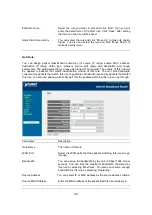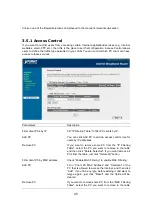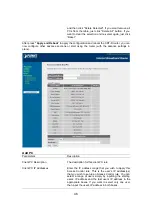
40
Trigger Type
Select whether the outbound port protocol is
“
TCP
”
,
“
UDP
”
or
both.
Public Port
Enter the In-coming (Inbound) port or port range for this type of
application (e.g. 2300-2400, 47624)
Note
: Individual port numbers are separated by a comma.
(e.g. 47624, 5775, 6541 etc.) To input a port range use a
“
dash
”
to separate the two port number range. (e.g. 2300-2400)
Public Type
Select the Inbound port protocol type:
“
TCP
”
,
“
UDP
”
or both.
Comment
The description of this setting.
Popular applications
This section lists the more popular applications that require
multiple connections. Select an application from the Popular
Applications selection. Once you have selected an application,
click the
Add
button. This will automatically copy the Port Trigger
information required for this popular application into the input
fields.
Add Special Application
Fill in the "Trigger Port", "Trigger Type
”
,
“
Public Port
”
, "Public
Type", "Public Port" and "Comment" of the setting to be added
and then click "Add". Then this Special Application setting will be
added into the "Current Trigger-Port Table" below. If you find any
typo before adding it and want to retype again, just click "Reset"
and the fields will be cleared.
If you want to add a popular application, select one
“
Popular
Application
”
and then click
“
Add
”
.
Remove Special Application
If you want to remove some Special Application settings from the
"Current Trigger-Port Table", select the Special Application
settings you want to remove in the table and then click "Delete
Selected". If you want remove all Special Application settings
from the table, just click "Delete All" button. Click "Reset" will
clear your current selections.
Click <
Save>
at the bottom of the screen to save the above configurations and press
“
Apply and
Reboot
”
to apply the configuration and reboot the XRT-D router. You can now configure other
advance sections or start using the router (with the advance settings in place).
Example: Special Applications
If you need to run applications that require multiple connections, then specify the port (outbound)
normally associated with that application in the "Trigger Port" field. Then select the protocol type
(TCP or UDP) and enter the public ports associated with the trigger port to open them up for
inbound traffic.
Example:
ID
Trigger Port
Trigger Type
Public Port
Public Type
Comment






























